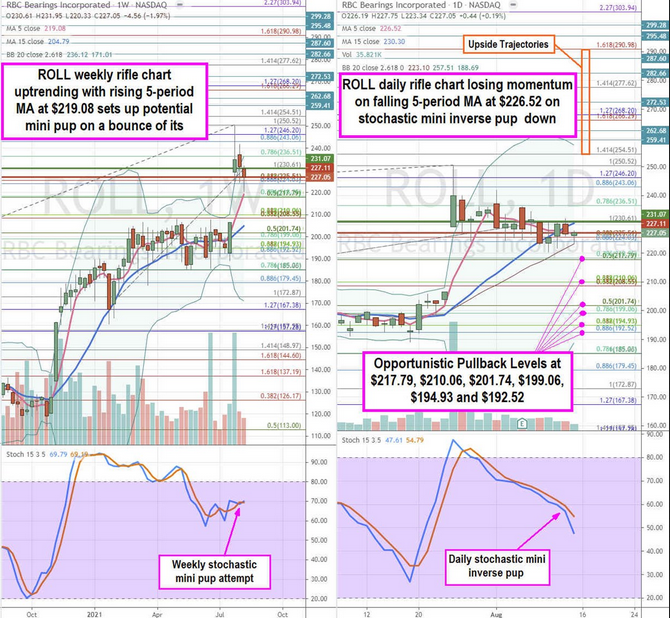Precision ball bearings manufacturer RBC Bearings (NASDAQ:ROLL) stock has been on a tear in 2021 as the reopening gets underway. Bearing are used in all kinds of products ranging from aircraft, engines, renewable energy, turbines, aerospace and satellite systems and industrial products. Clients include Boeing (NYSE:BA), Raytheon (NYSE:RTN), and Lockheed Martin (NYSE:LMT). Shares are trading off all-time highs on a filler quarter of earnings. The key acquisition of the DOGDE mechanical power transmission unit from ABB should accelerate earnings at a faster clip as it opens up more channels for revenues in industrial end products. The reopening and recovery post-pandemic is the key tailwind, the aerospace recovery specifically for the Company. The market still places a high premium on shares despite the lowered Q2 2022 revenue guidance, but these are temporary delays as the Company sets up for a strong recovery. Prudent investors seeking exposure can watch for opportunistic pullbacks in shares of RBC Bearings.
Q1 FY 2022 Earnings Release
On Aug. 5, 2021, RBC Bearings released its fiscal first-quarter 2022 results for the quarter ending June 2021. The Company reported an earnings-per-share (EPS) profit of $1.04 excluding non-recurring items versus consensus analyst estimates for $1.00, a $0.04 beat. Revenues fell (-0.2%) year-over-year (YoY) to $156.21 million falling shy of analyst estimates for $156.21 million. The Company issued downside guidance for Q2 2022 for revenues to come in between $158 million to $162 million versus $166.11 million consensus analyst estimates. RBC Bearings CEO, Dr. Michael Hartnett commented:
“First quarter results were in line with our expectations. Our team maintained a high level of execution which allowed us to build on the momentum from the fourth quarter. Strong order rates from industrial customers continued over the period; the outlook is one of increasing demand for our products as these markets continue to rebound. Following recent announcements of build rate increases for single-aisle commercial aircraft, we see escalating demand for our aircraft bearings and assemblies in the second half of the year.”
Conference Call Takeaways
CEO Hartnett set the tone:
“ We had some delays in shipments in one of our divisions as a result of source inspection, which is beyond our control. So that’s where we are. For fiscal quarter – for the first fiscal quarter of ‘22, sales of industrial products represented 48% of net sales, with aerospace products at 52%. Gross margin for the quarter was $63.8 million or 40.8% of net sales. This compares to $59.5 million or 38% for the same period last year. Adjusted operating income was $31.3 million, 20% of net sales compared to last year’s 19.1%. Adjusted EBITDA was $45.3 million, 29% of net sales compared to $43.8 million and 28% of net sales for the same period last year. We ended the quarter with $296 million in cash and securities and $10.8 million of debt.”
He explained the revenue shortfall should continue into Q2 due to delays which are beyond control. The OEM business rose 42% YoY with strong demand in all markets which the exception of oil and gas, which is making a comeback as of July.
Aerospace Recovery
The Boeing 747 Max seems to be the cause of shortfalls but is quickly recovering:
“Turning to aerospace and defense, this sector was off 18.3% for the quarter. Sequentially, when normalized for production days, it was about flat with the preceding period. Aircraft OEM was down almost 22.5%. This can be almost entirely attributed to the slow ramp of the 737 MAX programs through ‘21 and into calendar year ‘22, a problem that should resolve itself in the quarters ahead as Boeing steps through their monthly production rates from today’s 17 per month to January of 2023 of 42 per month, but we are now seeing increases in orders shippable later in the year across all of our plants that service and supply both Boeing and Airbus. Today, we are coming through over 200 – 2,000 line items, excuse me, bearings, and assemblies we supply to the industry to ensure we have materials, logistics and staff in place to seamlessly support the next 2 years of build rate increases. Regarding our second quarter, we are expecting sales to be between $158 million and $162 million.”

ROLL Opportunistic Pullback Levels
Using the rifle charts on the weekly and daily time frames provide a precision view of the price action playing field for ROLL stock. The weekly rifle chart gapped higher on earnings reaction peaking off the $250.52 Fibonacci (fib) level. The weekly 5-period moving average (MA) support is rising at $219.08 as shares fall back under the weekly upper Bollinger Bands (BBs) at $236.12. The weekly stochastic may be setting up a mini pup if shares bounce back up off that weekly 5-period MA, otherwise, a channel tightening towards the weekly 15-period MA at $204.79 can form on stochastic cross down. The daily rifle chart formed a market structure high (MSH) sell trigger under $227.05. However, the daily market structure low (MSL) buy triggers on a breakout through $231.07. The daily 5 period MA is falling on an initial downtrend at $226.52 as the daily stochastic forms a mini inverse pup. Prudent investors can watch for opportunistic pullback levels at the $217.79 fib, $210.06 fib, $201.74 fib, $199.06 fib, $194.93 fib, and the $192.52 fib. The upside trajectories range from the $254.51 fib up to the $290.98 fib price level.
